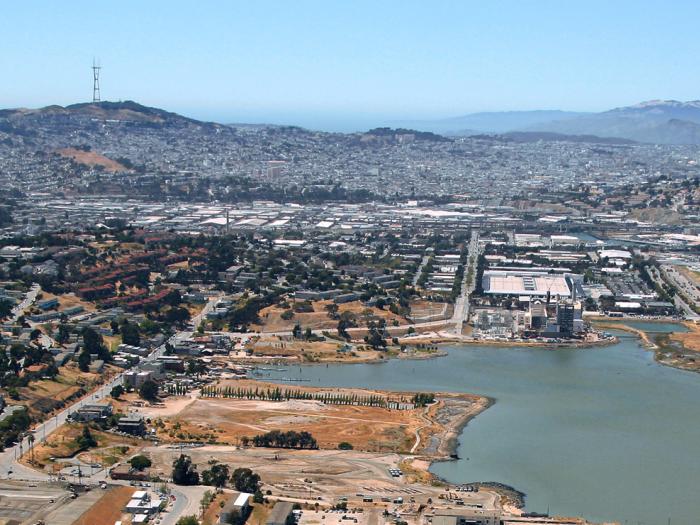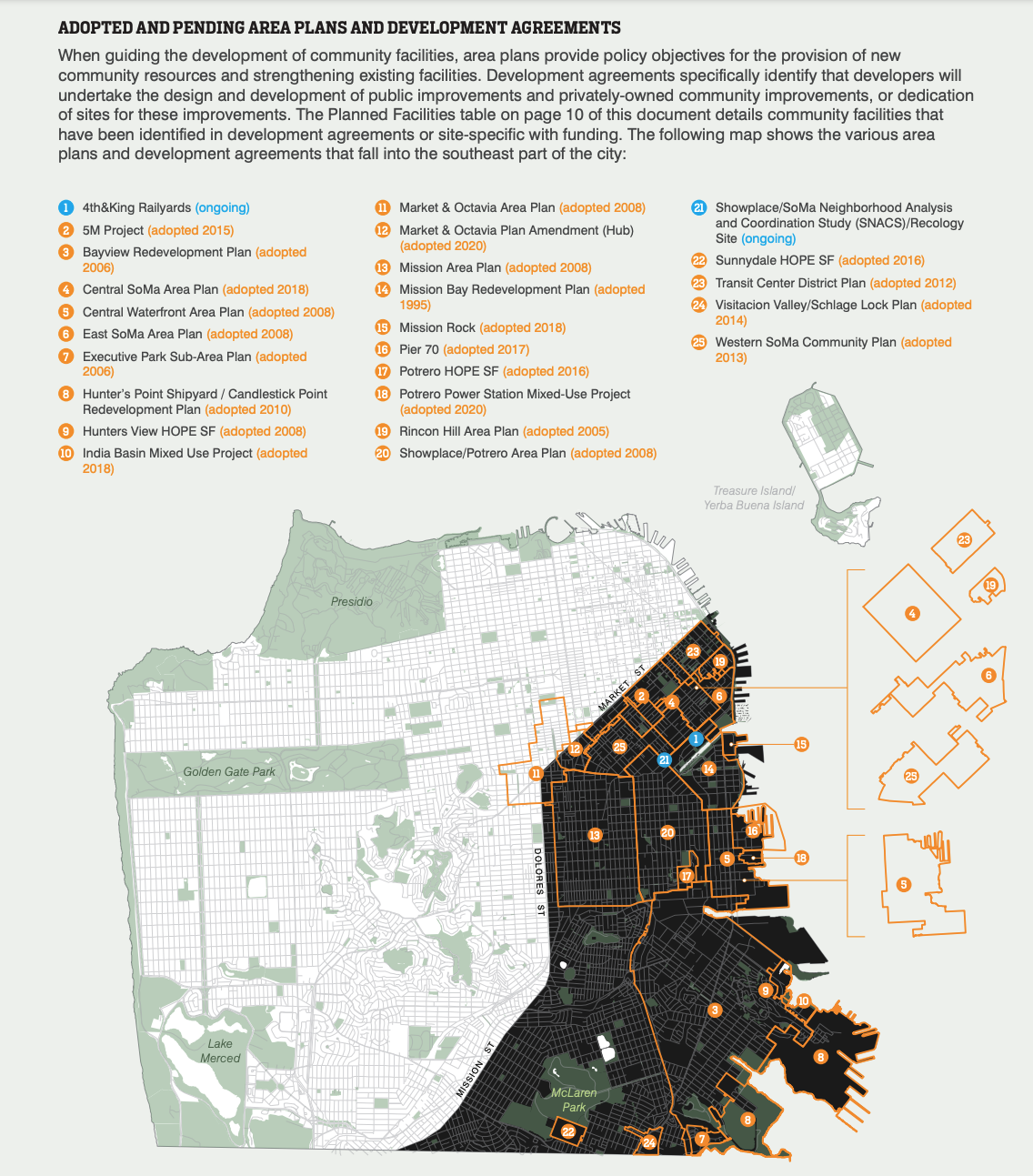
Southeast Framework
UPDATE July 2021 – The Southeast Framework seeks to ensure the new and growing neighborhoods in the southeast sector of San Francisco (SoMa to Candlestick Point) will have a quality of life and access to amenities and services equivalent to those available in neighborhoods throughout the City.
The purpose of the Southeast Framework is to identify standards for community facilities, present information on existing community facilities, and to analyze the impact of a growing population on existing facilities. The Framework also presents the key findings and recommendations for how to address the growing demand on community facilities in the Southeast.
Given that the southeastern part of the city expects 75% of the city’s future growth by 2040, the assessment of this impact on existing community facilities will help determine need for additional community infrastructure to provide for equitable access and appropriate amenities.
This report describes how this analysis fits into the City’s broader effort to coordinate development in the Southeast part of the City; the process of compiling analysis and key findings from conversations with City agencies; an overview of seven community facility types and identifying future needs; and, a summary of recommendations for new or expanded facilities and programming and operations for existing facilities.
Related Projects
The Planning Department is in the early stages of the Greater SoMa Community Facilities Needs Assessment, which aims to identify the capital needs of different types of community facilities in the greater South of Market area, including the Tenderloin, Mission Bay, Showplace Square and Market and Octavia neighborhoods. As the population of the SoMa area continues to grow, this assessment will help guide city agencies as they plan and allocate resources for new and improved facilities. Find out more.
Adopted and Pending Area Plans and Development Agreements
Findings and Recommendations
Key Findings
Based on extensive research, analysis, and conversations with seven City agencies, the following key findings across all studied facility types have been identified:
- All types of new community facilities are needed
- The focus of many agencies is on the expansion and renovation of existing facilities
- Standards for some facilities do exist but there isn’t a universal standard for how agencies plan for new facilities or expansion of existing facilities
- Staffing is a barrier to expanding services at existing facilities or creating new facilities.
- The price and availability of land are barriers to creating new facilities
- There is an opportunity to better coordinate among City agencies in the planning for new facilities and identifying the prioritization of new facilities
- New physical and programmatic models for community facilities are needed given the limited amount of available land and ongoing densification
- Geographic proximity does not equate to better access since facilities can be specific to certain needs or provide different services
- To accommodate population growth, new physical facilities are needed as well as adaptable programming to address the specific needs of the population served
- The COVID-19 pandemic has prompted the creative use of existing community facilities
General Recommendations
Based on the key findings, the following general recommendations have been developed:
- Allow and incentivize community uses at the ground floor
- Include new community space in master developments taking into account long term resilience to all hazards
- Study co-location of community facilities
- Maximize the use of existing City facilities
- Increase budget for staffing, management, and maintenance costs
- Ensure more robust data collection, data sharing and analytical capacity to better understand how facilities are used today and in the future
- Develop a citywide process to identify and prioritize new community facilities in development agreement (DA) projects
- Study the creation of a public lands policy for community facilities
- Engage in a community-led process in the planning for new community facilities and in making improvements to existing community facilities
- Apply a racial and social equity lens in the planning and programming of existing and future community facilities
Facility-specific Recommendations
Recommendations for Programming & Operations
Below are recommendations related to programming and operations for each individual agency. These recommendations are informed by GIS analysis, existing standards and conversations with City Departments.
Libraries
- Explore new service models and opportunities for more bookmobiles in the southeast. Consider co-locating a library with other community facilities that provide complimentary services, such as recreation centers, child care facilities and schools.
- Analyze not only the geographic location of libraries but also the different amenities and conditions of each library to determine whether there is equitable access for all residents. Explore opportunities in the South Downtown Area (SODA) in OCII properties where there is vacant retail at the ground floor.
Police Stations
- On June 20, 2020, the Mayor announced a plan to fundamentally alter the nature of policing in San Francisco. The public safety funds previously allocated to expansion of facilities or size of police force will be redirected toward efforts that will counteract structural inequalities that have led to disproportionate harm to the African American community. Given these changes, there are no recommendations to expand or analyze the need of new stations in this report.
Fire Stations
- Encourage the search for a new training facility in the southeast part of the City.
Public Health Centers
- Geographic proximity of health care facilities should be combined with services or programs most needed by the immediate residents.
- Assess public health facility needs as new demographic data comes available to ensure needs are being met.
- Consider co-locating health centers with other community facilities such as libraries or child care facilities.
Child Care Facilities
- Consider co-locating child care centers with other community facilities such as public health centers, recreation center, libraries, schools, etc.
- Explore new child care facilities in city owned and leased buildings.
- Consider child care facilities as a ground floor use in affordable housing developments.
- Work with private development to encourage and incentivize the construction of new child care facilities.
Recreation Centers
- Assess users of existing recreation facilities to understand needs and gaps in service, and adjust services and programming based on these needs.
- Continue to work with CBOs to allow use of RPD facilities when RPD-led programs are not taking place.
- Increase budget for staffing to expand services and programs in existing facilities.
Public Schools
- Coordinate City services with SFUSD as they plan for a new school in Mission Bay and in Bayview-Hunters Point.
- Explore new models for school facilities and consider mixed uses.
- Develop a five-year and a ten-year plan for new school facilities.
- Identify opportunities to include SFUSD in early discussions around available spaces for community facilities.
- Adjust planning for school facilities to respond to any further changes to the student assignment policy
Recommendations for New or Expanded Facilities (Near-Term)
Recommendations for community facilities that could be built in the near term (5-10 years) have been developed based on feedback from City agencies, a review of existing standards and informed by an inventory of planned community facilities included in the table on page 10 of the Southeast Framework report. Near term recommendations for new community facilities are summarized below and are in addition to what’s planned.
Libraries
- Expand library services and programming in planned spaces in each Hope SF site
Police Stations
- No additional facilities
Fire Stations
- Complete renovation and expansion of existing Treasure Island facility
Public Health Clinics
- No additional facilities
Child Care Facilities
- Additional 8,900 more infant/toddler spaces and 5,400 more preschool spaces in the Southeast. Approximately 700-1500 spaces will be met through planned facilities
Recreation Centers
- No additional facilities
Public Schools
- Develop schools on identified sites and consider where and how to increase additional capacity for student growth, whether through additional new sites or renovations at existing sites
- Explore feasibility of renovating existing school sites on Treasure Island in coordination with SFUSD and Treasure Island Development Authority (TIDA)
Jessica Look
Senior Planner
(628) 652-7455
jessica.look@sfgov.org

